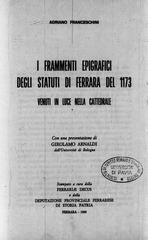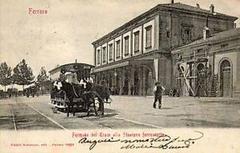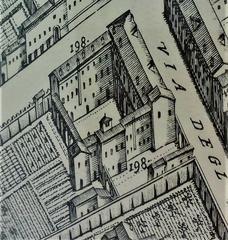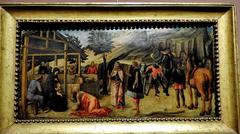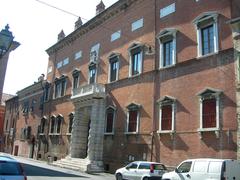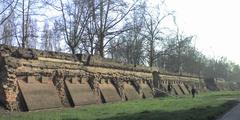
Delizia di Belfiore: Visiting Hours, Tickets, and Historical Sites in Ferrara
Date: 04/07/2025
Introduction
The Delizia di Belfiore, once a resplendent Renaissance villa of the Este family, stands today as a symbol of Ferrara’s artistic, cultural, and political legacy. Though largely destroyed, its rediscovery through ongoing archaeological excavation offers a unique opportunity to step into the world of Renaissance courts and experience living history. This comprehensive guide details the site’s historical significance, current visiting hours and ticketing information, travel tips, accessibility guidelines, and the rich array of nearby Ferrara historical sites. Whether you are a history lover, art enthusiast, or heritage traveler, the Delizia di Belfiore promises an unforgettable journey through the Este era’s splendor.
Table of Contents
- The Delizia di Belfiore: Origins and Este Vision
- Artistic and Cultural Legacy: The Studiolo and Renaissance Influence
- Decline, Destruction, and Rediscovery
- Visiting Delizia di Belfiore
- Community Engagement and Educational Value
- Visitor FAQs
- Conclusion and Practical Recommendations
- References
The Delizia di Belfiore: Origins and Este Vision
Commissioned by Alberto d’Este around 1388, the Delizia di Belfiore was among the most celebrated “delizie”—suburban villas that dotted the Ferrarese landscape as symbols of the Este family’s authority and refined tastes (CronacaComune; ItaliCom). Initially built outside Ferrara’s medieval walls, the palace came to be included in the urban fabric through the Herculean Addition at the end of the 15th century. Its strategic position, surrounded by lush gardens and the Parco del Barco hunting reserve, reflected the Este’s innovative Renaissance ideals—fusing nature, architecture, and courtly life (Inferrara).
Artistic and Cultural Legacy: The Studiolo and Renaissance Influence
Under Leonello d’Este’s rule (1441–1450), Belfiore reached its zenith as a cultural center. The famed Studiolo di Belfiore, Leonello’s private study, was adorned with a celebrated cycle of paintings of the Muses by Ferrarese masters such as Cosmè Tura and Angelo Maccagnino. These works, now displayed at the Pinacoteca Nazionale di Ferrara, are milestones in Renaissance iconography and a testament to the Este court’s patronage (Inferrara). The palace was a site for banquets, tournaments, and intellectual gatherings, serving both as a retreat for leisure and as a showcase for artistic innovation (Comune di Ferrara).
Decline, Destruction, and Rediscovery
Belfiore’s fortunes declined after the War of the Salt (1482–1483), during which it suffered substantial damage. A major fire in 1632 and subsequent dismantling by 1654 led to its near-total disappearance (CronacaComune). For centuries, its memory persisted only in historical texts and maps. However, recent participatory archaeological projects have revealed significant structural remains, fresco fragments, ceramics, and even organic materials—offering new insights into Este court life (Ferrara24ore; Archeomedia).
Visiting Delizia di Belfiore
Opening Hours & Ticketing
The Delizia di Belfiore is accessible to the public primarily through scheduled guided tours, typically organized during spring and autumn excavation campaigns. These tours coincide with key archaeological activities, offering rare opportunities to explore the site in depth (Gruppo Archeologico Ferrarese). Admission is often free or available for a modest fee, and advance booking is strongly recommended due to limited capacity. Updates on visiting hours and ticket availability are posted on the GAF events page and the Comune di Ferrara website.
Accessibility
As an active excavation site, the terrain is uneven and may not be fully accessible to visitors with mobility challenges. Paths have been adapted where possible, but comfortable footwear and outdoor attire are advised. If you require accessibility accommodations, contact organizers in advance.
Guided Tours & Educational Programs
Tours, led by archaeologists and local experts, provide engaging narratives about the palace’s history, ongoing discoveries, and the Este family’s cultural legacy. Educational programs are available for school groups and families, emphasizing hands-on participation in archaeological processes (Ferrara24ore).
Nearby Ferrara Historical Sites
Enhance your visit by exploring Ferrara’s other remarkable sites:
- Castello Estense: The iconic medieval castle at the city center.
- Palazzo dei Diamanti: Renowned for its Renaissance architecture and art exhibitions.
- Palazzo Schifanoia: Home to stunning Renaissance frescoes.
All of these sites contribute to Ferrara’s UNESCO World Heritage status (Travel Emilia Romagna).
Photography & Virtual Tours
Photography is usually allowed during open days—confirm with staff onsite. For those unable to visit in person, virtual tours and interactive maps are available through official websites, offering remote access to the site’s highlights.
Community Engagement and Educational Value
The “Che Delizia Belfiore!” project typifies participatory archaeology, involving students from local high schools and community volunteers in excavation, cataloging, and public outreach. This approach not only deepens historical understanding but also connects the public directly to Ferrara’s heritage (Comune di Ferrara).
Visitor FAQs
Q: What are the Delizia di Belfiore visiting hours?
A: The site is open only during scheduled guided tours, usually in spring and autumn. Check the GAF events page for current dates and times.
Q: How do I book tickets?
A: Reserve your spot in advance via the Gruppo Archeologico Ferrarese events page or by contacting [email protected].
Q: Is the site wheelchair accessible?
A: Accessibility is limited due to uneven terrain. Contact organizers ahead of your visit to discuss specific needs.
Q: Are guided tours available in English?
A: Tours are primarily in Italian, though English-language options may be arranged with prior notice.
Q: Can I visit the site independently?
A: No, access is permitted only through organized guided tours.
Q: What other Ferrara historical sites should I visit?
A: Don’t miss the Castello Estense, Palazzo dei Diamanti, and Palazzo Schifanoia.
Conclusion and Practical Recommendations
Plan your visit, engage with local guides and volunteers, and immerse yourself in the living heritage of Renaissance Italy.
References
- CronacaComune
- Ferrara24ore
- Comune di Ferrara
- Inferrara
- Travel Emilia Romagna
- Archeomedia
- Gruppo Archeologico Ferrarese
- La Nuova Ferrara
- FerraraToday
- StileArte

